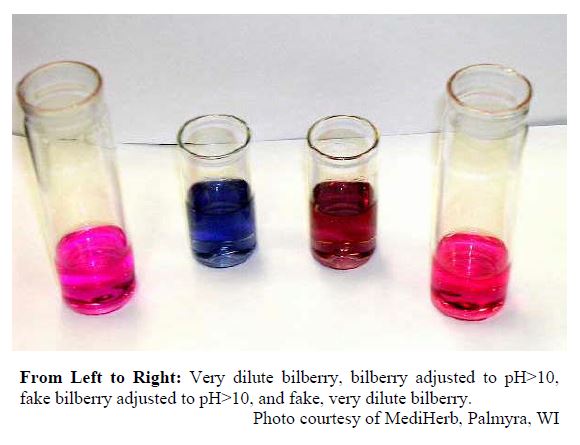Ensuring bilberry extract quality
Introduction
The American Herbal Products Association is providing here analytical tools and methods to identify adulteration of powdered raw materials labeled as bilberry (Vaccinium myrtillus) extract. There are well-established scientifically valid methods for determining the presence of red dye in materials purported to be powdered bilberry extracts. They are provided now as immediately available practical tools for industry in order to deal appropriately with reports of adulteration of this ingredient and make wise purchasing decisions.
"Bilberry" Extracts Adulterated with Artificial Dyes
In the process of evaluating commercial material labeled as bilberry extract, AHPA member company MediHerb investigated a sample that appeared to meet the listed specification for anthocyanin content by simple spectrometry. However upon further analysis it was discovered that this material was not likely derived from bilberry and was in fact adulterated with amaranth dye (red dye no. 2). Their work has since been published (see: Bilberry adulteration using the food dye amaranth. Penman KG, Halstead CW, Matthias A, De Voss JJ, Stuthe JM, Bone KM, Lehmann RP. J Agric Food Chem. 2006 Sep 20;54(19):7378-82).
Subsequent to the work by Penman et al., Steven Dentali, PhD, AHPA’s vice president of scientific and technical affairs, authored an article published in the trade journal Nutraceuticals World that warns lower price material available from nontraditional sources can be an initial indication of an adulterated extract. This is especially problematic where common methods of analysis are easily “cheated” so that a specification is met, but the material is not what it should be.
The information presented here is intended to educate industry about the potential quality problem with ingredients labeled as bilberry extract and to provide a scientifically valid method to aid in the differentiation between genuine bilberry fruit extract and material adulterated with amaranth dye. When examined with these methods by qualified individuals, information should be obtained that will allow more informed purchasing decisions than may be available with single wavelength spectroscopic analysis.
Methods for Detection of Dye in "Bilberry" Extracts
Anthocyanins turn blue at elevated pH
Bilberry extracts are blue-black in color but form a pink solution when diluted at neutral pH. At elevated pH, anthocyanins change color and anthocyanin-containing solutions, such as can be made by diluting bilberry extract with water, turn blue. This is illustrated below where the far left solution is very dilute true bilberry extract, next is this solution with the pH adjusted to greater than 10, next is dilute fake bilberry extract under the same conditions, and lastly very dilute fake bilberry extract.

This experiment is simple to replicate with bilberry extract or any other anthocyanin-containing materials and so is not necessarily indicative of bilberry anthocyanins. In fact this principle is easily observable by adding baking soda to dilute anthocyanin containing solutions. A “kitchen test” using diluted red wine, or grape juice, or other suitable (anthocyanin-containing) juice can be performed to illustrate this property of anthocyanins. Sprinkling baking soda into such a prepared dilute reddish solution will cause it to turn purple or bluish. This same color transformation will happen with bilberry (or other anthocyanin containing) extract, but does not occur with amaranth dye.
High performance thin layer chromatography (HPTLC)
Authentic bilberry can be easily differentiated from materials adulterated with amaranth dye under the HPTLC conditions used to create the image. Lanes 1 and 4 are authentic bilberry extract. The horizontal colored bands represent anthocyanin compounds. The adulterated samples in lanes 2 and 3 have a different pattern of colored bands and, most notably, a bright red band that corresponds to amaranth dye. The last lane shows what pure amaranth dye looks under these same conditions.
Other Relevant Sources of Bilberry Information
AHP and USP monographs
The American Herbal Pharmacopoeia and Therapeutic Compendium has published a bilberry fruit monograph that includes standards of analysis, quality control, and therapeutic information. More information can be found at https://herbal-ahp.org/all-causes/.
The United States Pharmacopeia has published a dietary supplement monograph for powdered bilberry extract as an in-process revision in the Pharmacopeial Forum, July–Aug. 2007;33(4):685-688.
Other compositional analysis and quantification of bilberry anthocyanins
The Journal of Agricultural and Food Chemistry has published a method of anthocyanin analysis in bilberry. That abstract can be accessed here.
A more recent paper published by the Journal of AOAC INTERNATIONAL “was developed and validated for the identification and quantification of both anthocyanins and anthocyanidins present in bilberry extracts and products.” The abstract for it is available here.
NUTRAfoods published a review of ten commercial bilberry extracts using USP/NF Pharmacopeial methods of analysis for anthocyanin content. Deficiencies were noted in labeling and content of many products. That article can be accessed here.
Acknowledgements
AHPA appreciates the contributions of member companies MediHerb for the technical work and CAMAG Scientific Inc. for the HPTLC method.